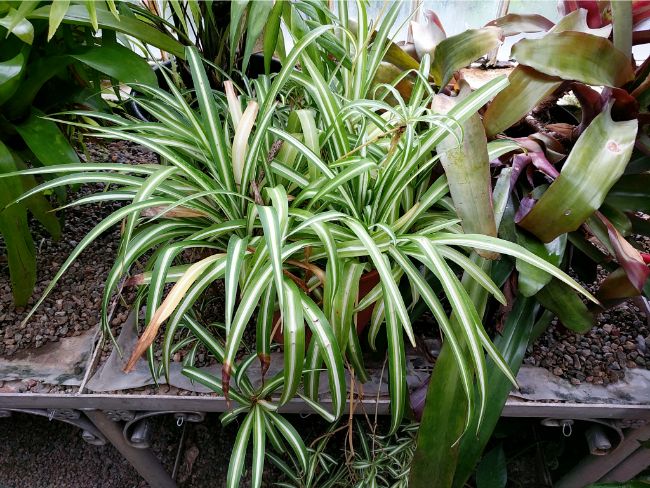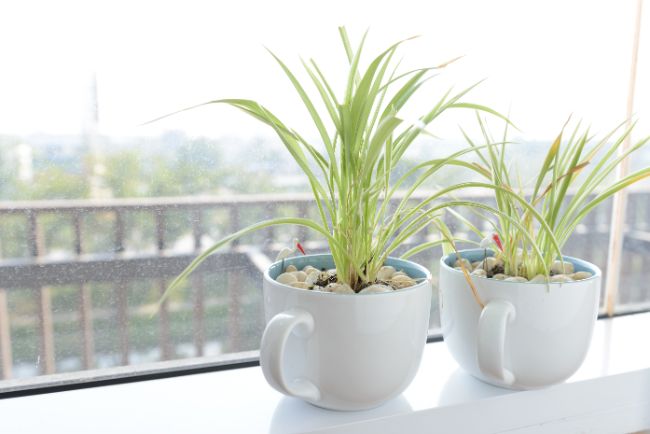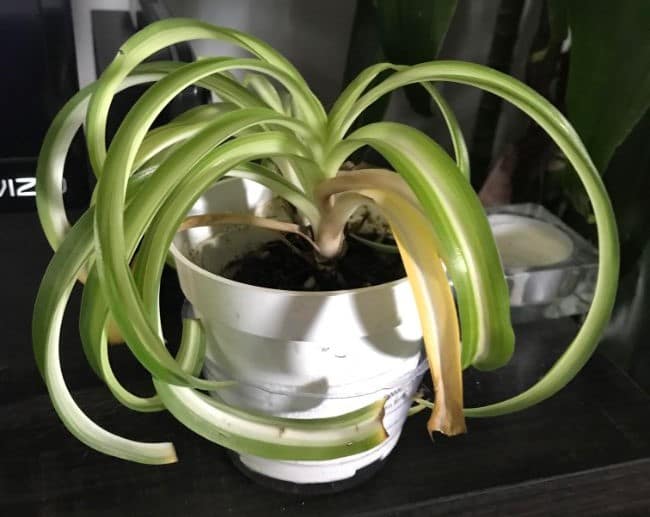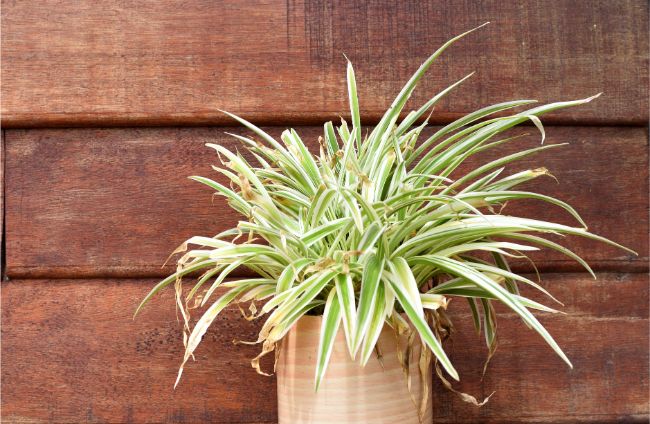Lush and easy to grow, Spider Plants (Chlorophytum comosum) are great for less attentive plant owners and beginners alike. Although generally easy to grow, yellow leaves on spider plants are a common issue. The good news is that the cause can be easily identified and fixed, as long as you know what to look for.
Why does your spider plant have yellow leaves? Yellow leaves on a spider plant can be caused by overwatering, incorrect lighting, overfertilization, high levels of fluoride or chlorine in the water, pests or disease. Yellow leaves or leaf tips is a sign your spider plant needs attention.
While spider plants tolerate a fair amount of neglect and a variety of conditions, you’ll find they have their limits. Once you know what those limits are and how to respect them, you’ll discover just how carefree spider plants can be.
Curing Yellow Leaves On Spider Plants
A healthy spider plant should have a dense cluster of elegant, gently curving foliage, with green and white variegation. The plant should feel energetic and just a little tense when you touch it; the leaves should not be overly soft or overly brittle.
If your spider plant’s leaves are starting to turn yellow, it means something is wrong with your plant. Run through this checklist to find out what the problem is:
- Check your plant’s light. Spider plants need access to sunlight, but excessive direct sunlight can lead to fading and yellowing of the leaves, and evidence of leaf burn. Insufficient lighting can also weaken your plant over time, leading to yellow leaves. Ensure your spider plant is positioned in bright, indirect light. A few hours of direct sunlight in the early morning or late afternoon is ok.
- Check your plant’s environment. A happy spider plant lives in a semi-humid environment with temperatures between 50-80°F. If it is positioned near an air conditioner or heater, this could be causing yellow leaves on your spider plant.
- Check your plant’s moisture levels. Your spider plant’s soil should be moist but not soggy. Underwatering will cause your plant to dry out. Overwatering will cause root rot. Both of these issues can lead to yellow leaves.
- Check the soil for mineral buildup. Avoid overfertilizing and flush the soil out every few months to avoid excess fertilizer salts accumulating in the potting soil. Consider repotting or start watering with distilled water.
- Check your plant for bugs. Aphids and mites can hide at the base of your plant and eat the leaves, turning them yellow or brown. Use natural methods to remove the pests so that your spider plant can return to health.
- Prune away any dead or dry leaves. Cutting off dry leaves that are yellow or brown will make room for your plant to grow new, healthy leaves instead. Prune a few leaves at a time to avoid shocking your plant.
- Repot your spider plant. Spider plants tend to continually outgrow the pots they are placed in. Look for a bigger pot that gives your plant room to grow. If it gets too big for its new container, you can divide your spider plant’s root ball to create multiple small but healthy plants.
A spider plant with yellow leaves is usually in the wrong environment, getting the wrong amount of light or water, and possibly suffering from a pot that’s too small. Give your spider plant some TLC, and the color will return to its leaves in no time.

1. Lighting Issues Causing Yellow Leaves On Spider Plants
Spider plants have been popular houseplants since the end of the 1700s. In nature, they typically grow beneath the shade of larger plants and trees, so they have adapted to thrive in bright, indirect lighting, rather than direct sun.
Too much direct sunlight will cause your spider plant’s leaves to turn yellow, wilt and burn. You might notice that the leaves are particularly dry and curling inward to protect themselves. If your spider plant is on a window sill, particularly at a south facing window, move it further from the window, or put a barrier between the plant and the window.
Alternatively, your spider plant might not be getting enough light. Plants without access to enough sunlight become weak and faded. If your spider plant has been sitting in a shady corner, move it to a location with brighter light from a nearby window.
Some plants also turn yellow from environmental shock. Plants don’t like to switch environments; they need time to adjust to new settings. If you have recently made a drastic change to your spider plant’s home setting, the leaves could temporarily turn yellow. Take good care of your plant, and it will eventually calm back down.

2. Temperature And Humidity Problems Cause Yellow Leaves On Spider Plants
First, check the temperature in your spider plant’s environment. Spider plants like to live in temperatures between 50-80°F. If you leave your spider plant outside, it might experience extremely hot or cold temperatures.
Next, think about the humidity in the room. Spider plants like medium levels of humidity, and very arid conditions can lead to brown or yellow tips on the leaves. If you are looking for good ways to increase humidity for your plants, check out my article on increasing humidity for your houseplants.
Houseplants should almost never be kept directly in front of air conditioners or heaters. Even if the room is at a healthy temperature, your plant could be experiencing a direct blast of hot or cold air through the vents.
Ambient heat might also be coming from your desktop computer, oven, or fireplace. Check to see what’s around your spider plant, and move it if necessary.
3. You Have Overwatered Or Underwatered Your Plant
Spider plants are tough, drought-tolerant plants that don’t need a lot of water to survive. Many spider plant owners significantly overwater their plants, and this can result in an unhappy plant with yellow leaves. A dried-out spider plant will also turn yellow, but this condition is significantly rarer.
You should let your spider plant’s soil dry out well between waterings. You know that it’s time to water again when the top half of the soil is dry; you can test this by poking your finger or a stick into the soil to detect dampness.
Water thoroughly and evenly, until water is draining out of the drainage holes in the pot. Ensure any drip tray is emptied after a few minutes to avoid the roots sitting in water.
Factors such as the size of pot, material of pot, plant size, potting mix and growing conditions will all impact how often your spider plant needs watered.
If the soil is taking a long time to dry out, or draining slowly, you should take action to reduce the risk of overwatering problems. Moisture that builds up in the soil can cause root rot, one of the few diseases that spider plants are susceptible to.
Root rot occurs when water sits around your plant’s roots, reducing the oxygen supply to the roots. Fungi and bacteria that live in the soil can start to multiply, and they’ll consider your plant as their first source of nutrition.
The solution to root rot is to repot your plant, into well draining and aerated potting mix, while removing any affected roots. Consider switching to a pot with adequate drainage.
Watering is one of the most important things to get right with houseplant care. I’ve written an article to help you master the art of watering indoor plants.

4. Excess Fertilizer Causes Yellow Leaves On Spider Plants
Overfertilizing, or fertilizer build up in the soil can cause nutrient toxicity and yellow leaves on your spider plant. Spider plants are not heavy feeders, so applying fertilizer once per month during the growing season is plenty.
Even if you feed your spider plant infrequently, some fertilizer salts can build up in the soil over time. This may appear as a white crust at the top of the soil in severe cases. Spider plants are quite intolerant of this and it is a common cause for yellow leaves or brown/yellow leaf tips.
You should flush the soil out with water every few months to rinse the salt out. This process is called leaching. This lets the fertilizer salts deposited in the soil dissolve and run out of the pot. To do this, I take my spider plant to the sink and run water through the soil for at least a few minutes. Always pour the water slowly to avoid harming your plant.
Even if you flush the soil, you should really repot your spider plant every 1-2 years. Use a well draining potting mix to ensure good aeration and to reduce the risk of overwatering.
5. The Type Of Water You Use Can Cause Your Spider Plant to Have Yellow Leaves
Spider plants are known for being sensitive to excess salts or chemicals in tap water like chlorine, fluoride, and soluble salts. When these build up in the soil of your plant and get into the roots and plant material, brown tips or yellow leaves will occur.
You may be able to check a water quality report from your local water authority website to see what dissolved minerals are present in your tap water.
If your spider plant has yellow leaves or brown tips and you just can’t work out why, I would definitely recommend switching to watering with rainwater, distilled water or filtered water. While distilled water will have the fewest dissolved minerals, any of these options will be better than tap water.
6. Your Plant Has Pests
One of the big signs that bugs are harming your spider plant is the presence of spots on the leaves. If a bug takes a bite out of a leaf, it will leave a small spot that turns yellow or brown with time.
The pests that might be attacking your spider plant include aphids, mealybugs, whiteflies, and the appropriately-named spider mites. Plants with spider mites often end up with yellow leaves; you’ll notice the color change before you see the actual bugs.
If pests are attacking your spider plant, you’ll typically find them on the underside or the base of the leaves. The leaves of a spider plant are clustered at the center of the plant, and this makes a great place for bugs to hide. Check out my article on how to get rid of houseplant bugs for natural solutions that won’t harm your spider plant.
Last Word
I hope this guide has helped you identify the cause of your spider plant’s yellow leaves. Don’t give up on your spider plant! Spider plants are extremely hardy, and with the right amount of care, yours can thrive once more.
I’ve written another article which covers other common problems with spider plants and how to fix them and another article which specifically covers the reasons why spider plants get brown tips.
For more information on the aspects of care that cause yellow leaves on spider plants, and for other articles you might enjoy, take a look at the following articles.

